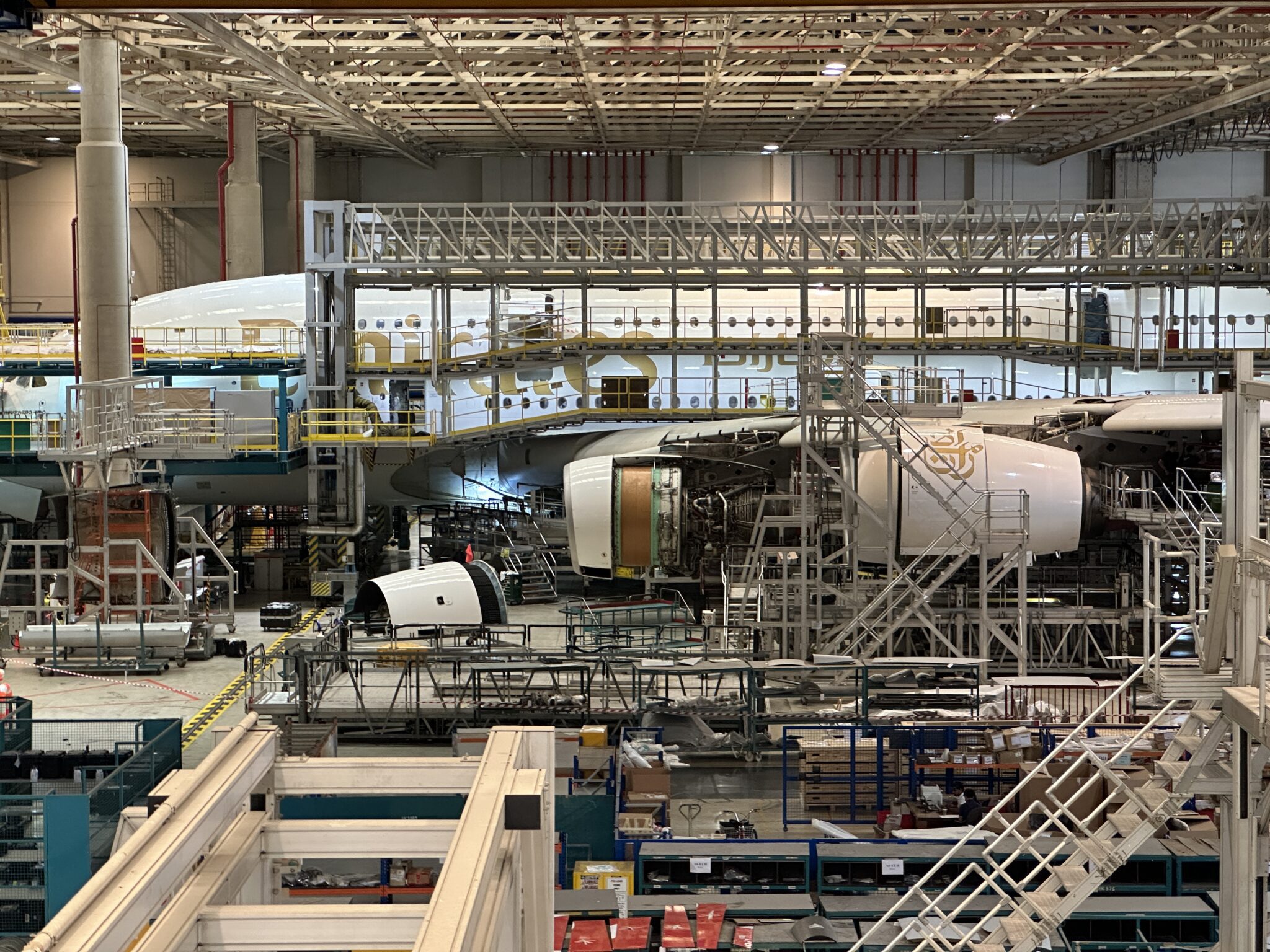When it comes to the Airbus A380 aircraft, only one airline truly bet its future on it: Emirates.
But Airbus scrapped the program. It had projected it would build 1,000 and ultimately delivered just 251. Emirates took 123 of them.
That presented a potential problem. Airlines like to keep widebody aircraft in their fleet for 20 to 30 years. With a limited market for the A380, the fear is there won’t be enough suppliers and service providers to provide upkeep into the 2040s. So Emirates is preparing for its future now.
Emirates invited Skift to the Emirates Engineering Centre at Dubai International Airport, where the airline maintains its aircraft, to showcase how it is preparing for the next two decades with the A380.
Emirates to Invest $950 million in New Facilities in Dubai
Emirates announced at the recently concluded Dubai Airshow that the airline will spend $950 million in new maintenance, repair and overhaul facilities at the Dubai World Central Airport (DWC), roughly 60 kilometers south of Dubai International Airport.
Emirates’ Head of Engineering, Ahmed Safa, expects that the first phase of the new facility will be ready in the second half of 2027, and it will have eight maintenance hangars and one paint hangar available at DWC.
There will also be a facility for engine runs, up to 20 support workshops and warehouse facilities for storing numerous parts.
Safa added that at DWC, the airline would eventually have 22 hangars (20 for maintenance and 2 for paint, apart from 2 engine areas), once the full scope of the DWC maintenance facilities are constructed.
Once ready, Emirates Engineering will move its heavy maintenance work on the A380s and 777s to DWC, with the DXB Engineering Centre being used for the upkeep of the Airbus A350 and Boeing 787s, which will start joining the fleet soon. Emirates will also have the 777X aircraft arrive, hopefully in 2025, in their fleet.
Project Phoenix: Emirates‘ Cabin Refresh Program to Keep Aircraft in the Air
Currently, Emirates has eight hangars for heavy maintenance and four for lighter checks at the Engineering Centre at DXB. Many of these are being used for Project Phoenix, the Emirates Cabin Refresh program, where Emirates will refurbish the interiors of 67 A380s and 53 Boeing 777 aircraft, apart from adding the Premium Economy Cabin.
Emirates runs the entire project in-house – it was launched in November 2022 and intended to be completed by May 2025. Emirates is only refurbishing the A380s at the moment, having completed work on 16 of them already. The Boeing 777 retrofits will go online from July 2024 onwards.
While each retrofit was initially expected to take 16 days to complete, Emirates Engineering has now combined the activity with the 6/12-year C-checks for the aircraft. Hence, an aircraft stays in the hangar longer, while fully ripped apart and reassembled, but with new seat upholstery and the new Premium Economy seats.
Emirates currently has 116 A380s remaining in its fleet, and it expects that by the turn of the decade, it will have 90 of these still flying.
The airline highlighted that the A380 is a product the Emirates customer loves, and the airline is proud of it as well. So, it is doing all it can to secure parts for the A380 aircraft, including taking apart some older aircraft, such as A6-EDA, and using its parts for spares.
Skift was shown the warehouse facility at Emirates Engineering, where spare parts worth over $1 billion are stocked.
The A380 wing spar issues, for which EASA, the European aerospace regulator, has issued an airworthiness directive, require specific inspection and repairs to all A380 aircraft every 3 years. Apart from its in-house maintenance facilities, the airline has also outsourced this maintenance work to Airbus in Toulouse and GAMECO in Guangzhou. Emirates expects to have the A380s flying well into the 2030s and early 2040s with all the upkeep they will perform on the aircraft.
Emirates also signed long-term deals with Collins Aerospace, Safran Landing Systems, Honeywell and Lufthansa Technik to support the A380 on the sidelines of the Dubai Airshow. But the highlight of the visit to the Emirates Engineering Centre was that the world’s largest widebody operator wants to be self-sufficient in its maintenance capabilities wherever it can.
Subscribe to Skift Pro to get unlimited access to stories like these
{{monthly_count}} of {{monthly_limit}} Free Stories Read
Subscribe NowAlready a member? Sign in here
Subscribe to Skift Pro to get unlimited access to stories like these
Your story count resets on {{monthly_reset}}
Already a member? Sign in here
Subscribe to Skift Pro to get unlimited access to stories like these
Already a member? Sign in here
